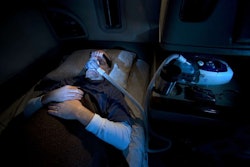About nine weeks ago, a driver for Cargo Transporters was heading to a delivery on a two-lane road near the company’s headquarters in Claremont, N.C. While rounding a corner, a passenger car began drifting toward him from the opposite direction.
The truck driver moved over to the shoulder. The car continued to move closer and clipped the front bumper of the truck. It could have been much worse. The truck driver avoided a head-on collision by swerving off the road and overturning his rig.
“The car driver told the state trooper at the scene that he was reaching for his cell phone,” says John Pope, chairman of Cargo Transporters. Even if the driver had not confessed the fault, Cargo Transporters could have proved its innocence immediately.
At the Truckload Carriers Associations’ annual conference in Las Vegas on March 4, Pope shared his experience implementing a risk management system from DriveCam.
Two years ago, Cargo Transporters began to equip its 450-truck fleet with the system. DriveCam consists of a window-mounted device that captures forward-looking and cab-facing video when a risky event occurs such as hard braking or swerving. The videos are uploaded each night to DriveCam’s server through a cellular modem for analysis and presentation to Cargo Transporters the following day through a web portal.
Sometimes the video recordings are triggered by a false positive, such as a driver hitting a large bump in the road. In these instances, some drivers have been caught not wearing a seat belt or showing signs of distracted driving, Pope says. Fleet managers use the videos to educate drivers on the need to buckle up or whatever the case may be.
Having video records of risky events has enabled fleet managers to have all the facts before contacting drivers to talk to drivers about safety. Every week the company uses the videos in its safety classes. Managers can give praise, where merited, to drivers who avoided would-be accidents caused by other drivers, he says.
In at least three cases, Cargo Transporters has been able to use video evidence to quickly show plaintiffs attorneys the company was not at fault and drop what would otherwise have been a frivolous lawsuit, he says.
“We are better off knowing all the facts,” he says.
As for driver acceptance of DriveCam, Pope says that fleet managers met individually with drives to allay their concerns about privacy. Nevertheless, about five drivers decided to part ways, he says.












